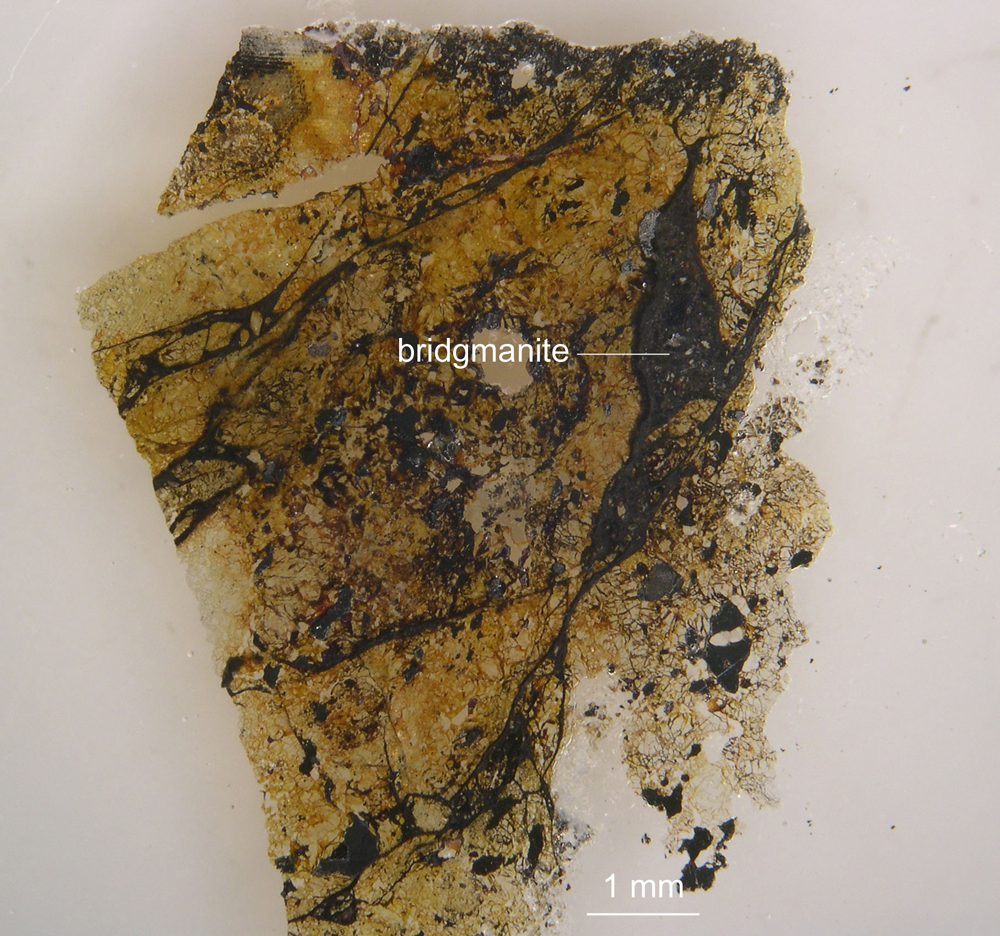Space Rock Sheds Light on Mysterious Mineral on Earth

A rock from space is giving scientists the first glimpse of a mineral long thought to be the most abundant mineral on Earth, but which researchers lacked a natural sample of until now.
This discovery could shed light on the structure and dynamics of the inner Earth, as well as the early history of the solar system, according to the new paper.
"The search for this mineral in meteorites has been going on for decades — it was just a matter of finding the right method for detecting it," said lead study author Oliver Tschauner, a mineralogist at the University of Nevada, Las Vegas.
The mineral is a high-density version of magnesium iron silicate. It is the most abundant mineral on Earth, and makes up about 38 percent of the planet's volume. But it's only stable at very high pressures and temperatures, so for decades, researchers had only seen lab-generated versions of it. [Fallen Stars: A Gallery of Famous Meteorites]
Under the heat and pressure found in Earth's lower mantle, which extends from about 410 to 1,615 miles (660 to 2,600 kilometers) below the planet's surface, magnesium silicate can form what is called a perovskite structure, which can be imagined as an array of double pyramids that are joined at their corners. The centers of each pyramid are made of silicon, the apexes and corners are made of oxygen, and magnesium and iron reside in the spaces between each double pyramid.
But scientists had not discovered a naturally occurring version of this mineral until now — the mineral would not survive the long journey from the lower mantle to Earth's surface because it would readily transform into lower-density minerals.
The fact that scientists had not found any specimens of magnesium iron silicate perovskite in nature also meant it could not get an official mineral name from the International Mineralogical Association. This presented geologists with the odd situation of a nameless mineral being the most abundant one on Earth.
Get the Space.com Newsletter
Breaking space news, the latest updates on rocket launches, skywatching events and more!
Since researchers could not find a naturally occurring version of magnesium iron silicate perovskite from Earth, they instead looked to space. They hypothesized that high-speed cosmic impacts could generate the pressures and temperatures needed to create this mineral, and samples of it could then come to Earth as meteorites knocked off their parent asteroids or planets.
Recently, Tschauner and his colleagues carefully isolated magnesium iron silicate perovskite in a meteorite. The mineral was given has the official name of "bridgmanite," after the father of high-pressure experiments, Nobel laureate Percy Bridgman, according to the report, published in the Nov. 28 issue of the journal Science.
The researchers analyzed a Tenham meteorite, a rock that was part of a meteor shower that rained down on Australia on a spring night in 1879. This meteorite bore signs that it was part of an asteroid that experienced a great impact. The stone also possessed minerals called akimotoite and ringwoodite, which are similar in composition and origin to bridgmanite.
In prior attempts to find bridgmanite in meteorites, researchers often used electron microscopes. However, this strategy involves probing the rocks with electron beams that can turn bridgmanite to glass. Instead, Tschauner and his colleagues used high-energy X-rays from a synchrotron, a kind of particle accelerator. These intense X-rays do little damage to bridgmanite, thus helping the scientists prove its composition and crystal structure.
The researchers found that bridgmanite was higher in iron and sodium than they had expected based on synthetic samples. "This gives interesting insights for what might be going on in the lower mantle," Tschauner said.
Tschauner added that detecting bridgmanite in other meteorites could shed light on the strength of the impacts their parent bodies experienced. The pressures and durations of these impacts in turn "allow us to estimate the size of the parent bodies of these meteorites, and with enough data, we can, for given points in time in the solar system's history, figure out how large bodies in the solar system were," Tschauner said.
Follow Live Science @livescience, Facebook & Google+. Original article on Live Science.
Join our Space Forums to keep talking space on the latest missions, night sky and more! And if you have a news tip, correction or comment, let us know at: community@space.com.

Charles Q. Choi is a contributing writer for Space.com and Live Science. He covers all things human origins and astronomy as well as physics, animals and general science topics. Charles has a Master of Arts degree from the University of Missouri-Columbia, School of Journalism and a Bachelor of Arts degree from the University of South Florida. Charles has visited every continent on Earth, drinking rancid yak butter tea in Lhasa, snorkeling with sea lions in the Galapagos and even climbing an iceberg in Antarctica. Visit him at http://www.sciwriter.us

